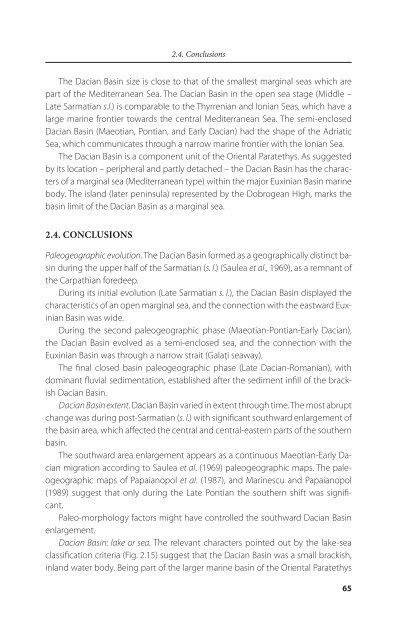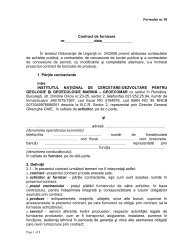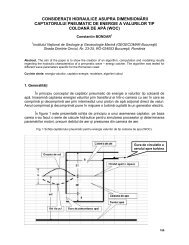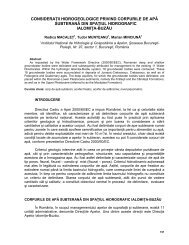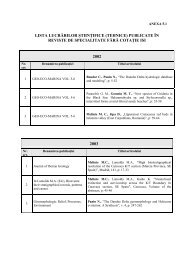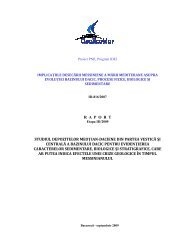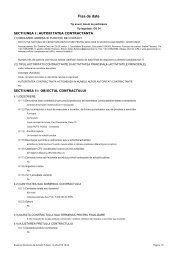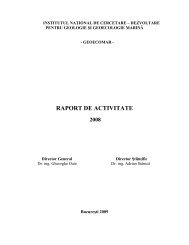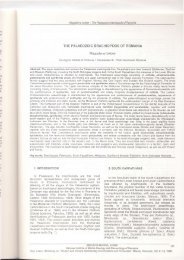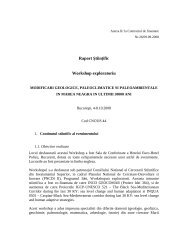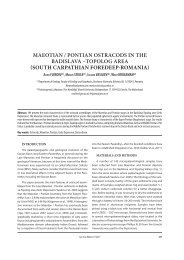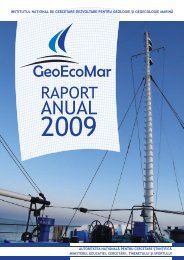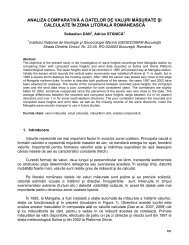DACIAN BASIN - GeoEcoMar
DACIAN BASIN - GeoEcoMar
DACIAN BASIN - GeoEcoMar
Create successful ePaper yourself
Turn your PDF publications into a flip-book with our unique Google optimized e-Paper software.
2.4. Conclusions<br />
The Dacian Basin size is close to that of the smallest marginal seas which are<br />
part of the Mediterranean Sea. The Dacian Basin in the open sea stage (Middle –<br />
Late Sarmatian s.l.) is comparable to the Thyrrenian and Ionian Seas, which have a<br />
large marine frontier towards the central Mediterranean Sea. The semi-enclosed<br />
Dacian Basin (Maeotian, Pontian, and Early Dacian) had the shape of the Adriatic<br />
Sea, which communicates through a narrow marine frontier with the Ionian Sea.<br />
The Dacian Basin is a component unit of the Oriental Paratethys. As suggested<br />
by its location – peripheral and partly detached – the Dacian Basin has the characters<br />
of a marginal sea (Mediterranean type) within the major Euxinian Basin marine<br />
body. The island (later peninsula) represented by the Dobrogean High, marks the<br />
basin limit of the Dacian Basin as a marginal sea.<br />
2.4. CONCLUSIONS<br />
Paleogeographic evolution. The Dacian Basin formed as a geographically distinct basin<br />
during the upper half of the Sarmatian (s. l.) (Saulea et al., 1969), as a remnant of<br />
the Carpathian foredeep.<br />
During its initial evolution (Late Sarmatian s. l.), the Dacian Basin displayed the<br />
characteristics of an open marginal sea, and the connection with the eastward Euxinian<br />
Basin was wide.<br />
During the second paleogeographic phase (Maeotian-Pontian-Early Dacian),<br />
the Dacian Basin evolved as a semi-enclosed sea, and the connection with the<br />
Euxinian Basin was through a narrow strait (Galaţi seaway).<br />
The final closed basin paleogeographic phase (Late Dacian-Romanian), with<br />
dominant fluvial sedimentation, established after the sediment infill of the brackish<br />
Dacian Basin.<br />
Dacian Basin extent. Dacian Basin varied in extent through time. The most abrupt<br />
change was during post-Sarmatian (s. l.) with significant southward enlargement of<br />
the basin area, which affected the central and central-eastern parts of the southern<br />
basin.<br />
The southward area enlargement appears as a continuous Maeotian-Early Dacian<br />
migration according to Saulea et al. (1969) paleogeographic maps. The paleogeographic<br />
maps of Papaianopol et al. (1987), and Marinescu and Papaianopol<br />
(1989) suggest that only during the Late Pontian the southern shift was significant.<br />
Paleo-morphology factors might have controlled the southward Dacian Basin<br />
enlargement.<br />
Dacian Basin: lake or sea. The relevant characters pointed out by the lake-sea<br />
classification criteria (Fig. 2.15) suggest that the Dacian Basin was a small brackish,<br />
inland water body. Being part of the larger marine basin of the Oriental Paratethys<br />
65


